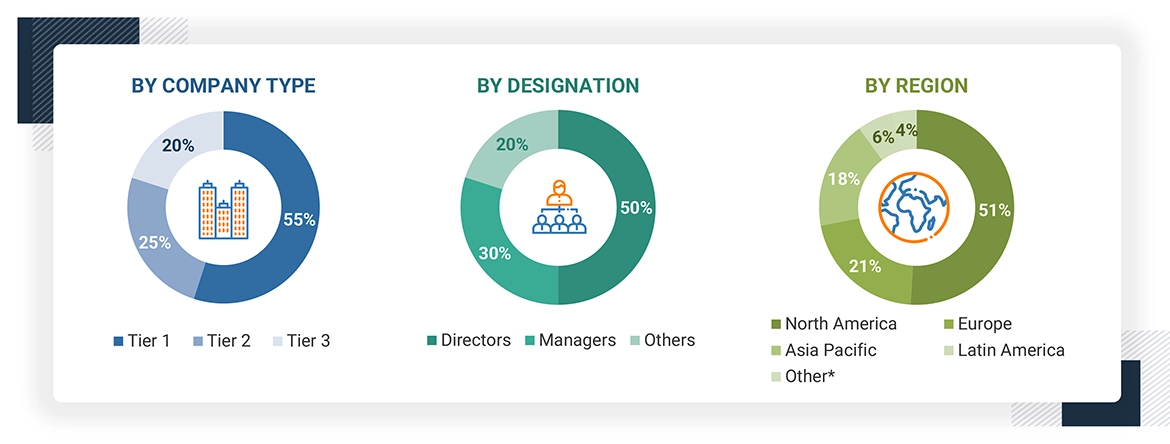This study involved four major activities in estimating the current size of the minimal residual disease testing market. Exhaustive secondary research was carried out to collect information on the market, its peer markets, and its parent market. The next step was to validate these findings, assumptions, and sizing with industry experts across the value chain through primary research. Both top-down and bottom-up approaches were employed to estimate the complete market size. After that, market breakdown and data triangulation procedures were used to estimate segments and subsegments' market size.
Secondary Research
In the secondary research process, various secondary sources such as annual reports, press releases & investor presentations of companies, white papers, certified publications, articles by recognized authors, gold-standard & silver-standard websites, regulatory bodies, and databases (such as D&B Hoovers, Bloomberg Business, and Factiva) were referred to identify and collect information for this study.
Primary Research
In the primary research process, various sources from both the supply and demand sides were interviewed to obtain qualitative and quantitative information for this report. Primary sources were mainly industry experts from the core and related industries and preferred suppliers, manufacturers, distributors, service providers, technology developers, researchers, and organizations related to all segments of this industry’s value chain. In-depth interviews were conducted with various primary respondents, including key industry participants, subject-matter experts, C-level executives of key market players, and industry consultants, to obtain and verify the critical qualitative and quantitative information as well as assess prospects.
The following is a breakdown of the primary respondents:

Note 1: Others include sales managers, marketing managers, and product managers.
Note 2: Companies are classified into tiers based on their total revenues. As of 2022/2023, Tier 1 = >USD 100 million, Tier 2 = USD 10 million to USD 100 million, and Tier 3 = < USD 10 million.
To know about the assumptions considered for the study, download the pdf brochure
|
COMPANY NAME |
DESIGNATION |
|
Roche Ltd. |
General Manager |
|
Gaurdant |
Area Sales Manager |
Market Size Estimation
Both top-down and bottom-up approaches were used to estimate and validate the minimal residual disease testing market's total size. These methods were also used extensively to estimate the size of various subsegments in the market. The research methodology used to estimate the market size includes the following:
-
The key players in the industry have been identified through extensive secondary research
-
The revenues generated by leading players operating in the minimal residual disease testing market have been determined through primary and secondary research
-
All percentage shares, splits, and breakdowns have been determined using secondary sources and verified through primary sources
The research methodology used to estimate the market size includes the following:
Data Triangulation
After arriving at the overall market size applying the process mentioned above, the total market was split into several segments and subsegments. To complete the overall market engineering process and arrive at the exact statistics for all segments and subsegments, data triangulation and market breakdown procedures were employed, wherever applicable. The data was triangulated by studying various factors and trends from both the demand and supply sides.
Market Definition
Minimal Residual Disease (MRD) refers to the small number of cancer cells left in a body after cancer treatment. MRD tests are performed to diagnose and monitor patients with various hematology cancers, such as leukemia, lymphoma, and myeloma. An MRD test looks for cancer cells not killed by chemotherapy or other cancer treatments. Moreover, these tests also play a crucial role in clinical trials of hemato-oncology therapeutics.
Stakeholders
-
Senior Management
-
End User
-
Finance/Procurement Department
-
R&D Department
Report Objectives
-
To define, describe, segment, and forecast the global minimal residual disease testing market by product, technology, application, end user, and region
-
To provide detailed information regarding the major factors influencing the market growth (such as drivers, restraints, opportunities, and challenges)
-
To analyze micromarkets with respect to individual growth trends, prospects, and contributions to the overall minimal residual disease testing market
-
To analyze market opportunities for stakeholders and provide details of the competitive landscape for key players
-
To forecast the size of the market segments with respect to five regions, namely, North America, Europe, the Asia Pacific, Latin America, and the Middle East & Africa
-
To profile the key players and comprehensively analyze their product portfolios, market positions, and core competencies
-
To track and analyze company developments such as product launches, agreements, partnerships, and acquisitions in the minimal residual disease testing market
-
To benchmark players within the market using the proprietary "Competitive Leadership Mapping" framework, which analyzes market players on various parameters within the broad categories of business and product strategy



Growth opportunities and latent adjacency in Minimal Residual Disease Market